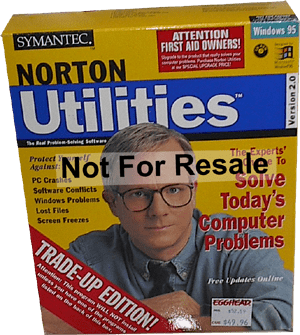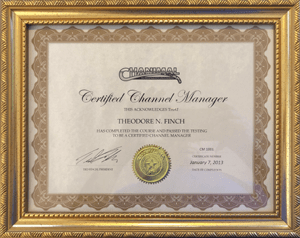Reseller Training
In PC retail (not mass merchants), 67% of everyone who comes into the store asks the sales rep for a recommendation, and 97% follow it–and reseller training increases this ratio. That means that 65% of the product that goes out of the store is determined by the product name that comes out of a sales rep’s mouth. With VARs and System Integrators, the ratio is even higher (over 80%)! This is why it is so important to “brand” the reseller on your product. This ratio is known as the almighty “Reseller Recommendation Rate,” and I built an entire company (that grew to over 4,000 in four years) by providing a service to increase this rate.
In fact, with 65% or more of your influence occurring with the reseller, branding the reseller can be the most effective use of your budget–even greater than branding customers. I used this information once at the 5th largest software company while I was a Channel Manager. We started by reducing the ad budget from $600k to about $190k. We then used the savings to train the resellers and plant seed copies (Not for Resale (NFR) copies).

We reduced our consumer branding, and let the competitor achieve more “brand” recognition with the customer… and drive them into retail–and then we switched them at the site! Because of this and a few other changes, we effected a 290% growth in the product line in a market category with only a 10% growth rate.
The best way to brand the reseller is to get them up to speed on your product’s competitive positioning, its features, unique value to customers, and how it works. This occurs best during one-on-one store/rep training. After the reps are trained, usually 15 to 40 minutes is all it takes, and the all-powerful “reseller recommendation ratio” increases dramatically.
I tested 200 resellers before a massive training campaign by calling blind and asking them over the phone which product (in my category) would they recommend. 76% of them chose my #1 competitor, 21% selected my product, and the other 3% went to 3 other vendors (one soon went out of business). After the rep/store training, I called the same 200, got about 125 of the same people on the phone who had seen our training demo, and the ratio that recommended my product was then 71%–almost a complete reversal of our previous ratio with the competitor!
Later, I was asked to talk with the press about branding. The writer wanted to know how to brand the customer. I could see where he was coming from since branding a customer was critical when I used to be in pure consumer marketing–especially since almost everything was bought on brand and price, without any help from the store reps (except for the butcher). However, the model was different in a market that often required help from a store rep to make a decision–in PC retail.
I then helped the writer change the direction of his article by explaining that the greatest brand should be with the reseller. Of course, as PC products became more consumerized, some brands became more critical to the consumer (such as Microsoft, Quicken, etc.), but the reseller is still a massive influence in determining which product a PC customer purchases within many categories.

Seed Copies (Not-For-Resale NFR)
To ensure a longer conversion, I also sell the reseller an NFR copy after they have been trained on the product, usually at a ridiculously low cost (usually at my cost of goods, or between $10 and $20 each). I don’t want to make money off the salespeople (who I consider an extension of my own direct sales force), but I do want to ensure that they start using my product. This is because resellers sell and recommend what they know, and they know best what they use.
For SaaS, it is NFR Access, since there is no physical product.
By the way, if a reseller gets the NFR copy, but doesn’t install it, it doesn’t do you any good. I’ve found, from giving away and selling thousands of NFR copies, that the adage holds, “What we obtain too cheaply, we value too little.” 
BTW, you don’t always have to sell your NFR. The key is “skin in the game.” I found that answering quiz questions about the product does the same thing. When they think, “I had to pay… or I had to answer all those questions,” it works the same.
To train resellers with your own sales force is slow and costly. It is usually much more cost-effective to hire and train an external firm to do this–especially since they can often combine you on a tour with other complementary vendors and cut your overall cost to 1/4 to 1/5th of doing it yourself–plus they can cover more ground, quicker.
I was one of 13 that started a reseller training company in 1989–this company grew to over 4,000 people and was used to help launch over 400 products by over 150 vendors including Microsoft (who validated the brand value and ratios), Lotus, Autodesk, WordPerfect, Adobe, IBM, Canon, HP, Corel, Aldus, Mitsubishi, and smaller companies that eventually grew or were acquired like Delrina (Winfax), Samna (Ami Pro became Lotus WordPro), Creative Labs, etc. Follow this link to find companies that can help with reseller training.
* These figures came out of a study by Computer Reseller News. Years later, at TempReps (which conducted over 1 million promotions for Microsoft, Canon, Lotus, IBM, Corel, Adobe, Autodesk, and others), the figure was almost identical.
Market & Promotional Training
Once signed up, VARs need to be trained on:
- The portal site (including how to access, the specific policies (lead policies, deal registration), where to find pricing and support, available demo scripts and PowerPoints, etc.)
- The product (including its unique positioning in your space)
- The market (especially the market segments that are most likely to purchase your product), and
- How to effectively promote your product–in that order.
With some complementary or add-on products, the VARs can go to existing accounts and sell-in your product (account management), for others, they must prospect. Like any sales team, they seldom like to prospect via cold calls–they prefer leads. If you have a lot of them, then great–they can follow your lead retrieval and follow-up process. If not, then they must run promotions to get their own.
Resellers typically don’t have a marketing department and are normally not very good at generating leads. This is where you can help and it goes a long way to generating partner loyalty. You can provide templates (e-mails, ads), event schedules, and other items that have a proven response to your product to jump-start their efforts.

Certification
When you have a tiered partner program with Authorized, Gold, or Platinum (examples), you typically differentiate the levels as follows:
- Authorized. Have to know the basics of setup, and how the product works. But they do not have a quota, nor do they have to handle tech support (aside from knowing the product well enough to sell it and set it up). No leads.
- Gold. Would have to supply first-line support (so they have to get certified (trained and tested). They also have the 1st level of quota. In return, they get a higher margin and can get leads.
- Platinum. Handle 1st and 2nd line support (so require the highest level of training & certification). They also have the highest quota. They would get the highest margin and usually 2-3x the Gold level leads.
You then have to create the training material so they can handle first-line support. It’s not that difficult–what kind of training do you do for your support team, and then your 2nd line support? If it is documented, then you would use that material to train your resellers. If you don’t have any training material, you will need to create it–that’s the only way to scale (or you will have to handle all support forever).
It would typically cover all the basics (install, setup, configurations), plus the FAQs that you typically receive. You will need to poll your support team for the answers. You would start with an outline and then fill in the answers. Then you would combine written details, plus a video showing how it is done in the training section of your portal site.
You would follow the same process for the 2nd line support, which typically includes more advanced material, scripting, and integration–whatever your 2nd line support handles currently. This is an area I can’t help with–since it is product-specific.
In addition to product training, you would typically include sales training, basic market information, how to run marketing promotions, etc.
Here is an example of an excellent product training methodology (video, text, and screenshot) from the Calendar program, Amelia. It’s not displayed in an LMS, but it is a very effective format for product training.
Learning Management System (LMS)
We do training at our facilities, from 3rd party facilities (Horizon’s, etc.), and sometimes on-site (with the big partners like CDW, at the reseller’s national meetings, etc.), but nowadays, we can create all our training online–using a learning management system (LMS). There are several open-source systems, and some used by universities–but I prefer the ones made for training business partners.
I typically use two WordPress systems: LearnDash (used for the Chanimal Certification Program, more robust and more all-inclusive) and LearnPress (used inside the Chanimal / SaaSMAX portal, easy to use, uses a modular approach, easy to support). WordPress versions work well, can be integrated, and are affordable–but they require a lot of system setup and most need numerous plug-ins.
For non-WordPress sites, I’ve scoured through about 5o or so sources (G2Crowd, Captera, dozens of online reviews), have tried and exhausted probably 40 hours with multiple big open source LMS systems (Canvas, Moodle, Chamilo, Blackboard, Coassemble, Litmos, TalentLMS, Docebo, Edmondo, Academy of Mine, etc.).
Many of these are incredibly complicated, have a lot of features specific to online classrooms (not self-serve), and/or are VERY expensive. Others seem fine until you realize they are a framework application and you have to create your courses with course authoring software and then use SCORM and other approaches to publish. There are SO many choices–but most were disappointing for a self-serve certification program. Some, like Udemy or SkillShare, are marketplaces, so you don’t always have control over student data or policies (refund, discount, etc.).
I also wanted to create the videos and write the content in one place. The WordPress versions allow this, but the combination of plugins to make them work can be daunting and time-consuming.
A relatively new system I found was Thinkific.com (similar to Teachable–but Teachable takes a percentage of revenue for the lower plans, 10% for free, plus 2% for BackOffice payouts (not obvious during signup) which can add up). Here is a review between Thinkific and Teachable (opens own window).
This is a self-contained LMS (with e-commerce) that does not require as much technical know-how, allows unlimited video upload (always a problem, since you’re not supposed to have unlisted commercial training material that is accessible behind a password on YouTube), and allows you to add your content and link within their system. Plus, the price is VERY affordable (including free for 3 courses (which may be fine for vendors)). Their paid program charges a fixed monthly fee for unlimited students and content and does not take a % of your course revenues.
LearnDash Video
Resources to Help Your Partners
If you don’t have marketing templates to help your resellers, you may wish to help them hook up with groups like TechnologyMarketingToolkit.com. Robin Robins specializes in helping VARs and System Integrators to promote their business and generate leads. She would be the equivalent to Chanimal, but to the VARs, not the vendors. I highly recommend you check out her services and refer her to your reseller partners. You may wish to even order her CD-ROM to see how she can help your channel partners.
Contact Info
Chanimal, Inc.
12109 Lake Stone Dr
Austin, TX 78738
512-263-9618
Click HERE to Email
Follow us on Facebook
NOTICE
I join a LOT of affiliate programs (connoisseur–like to see what they do), including Amazon, so there may be links throughout Chanimal.

